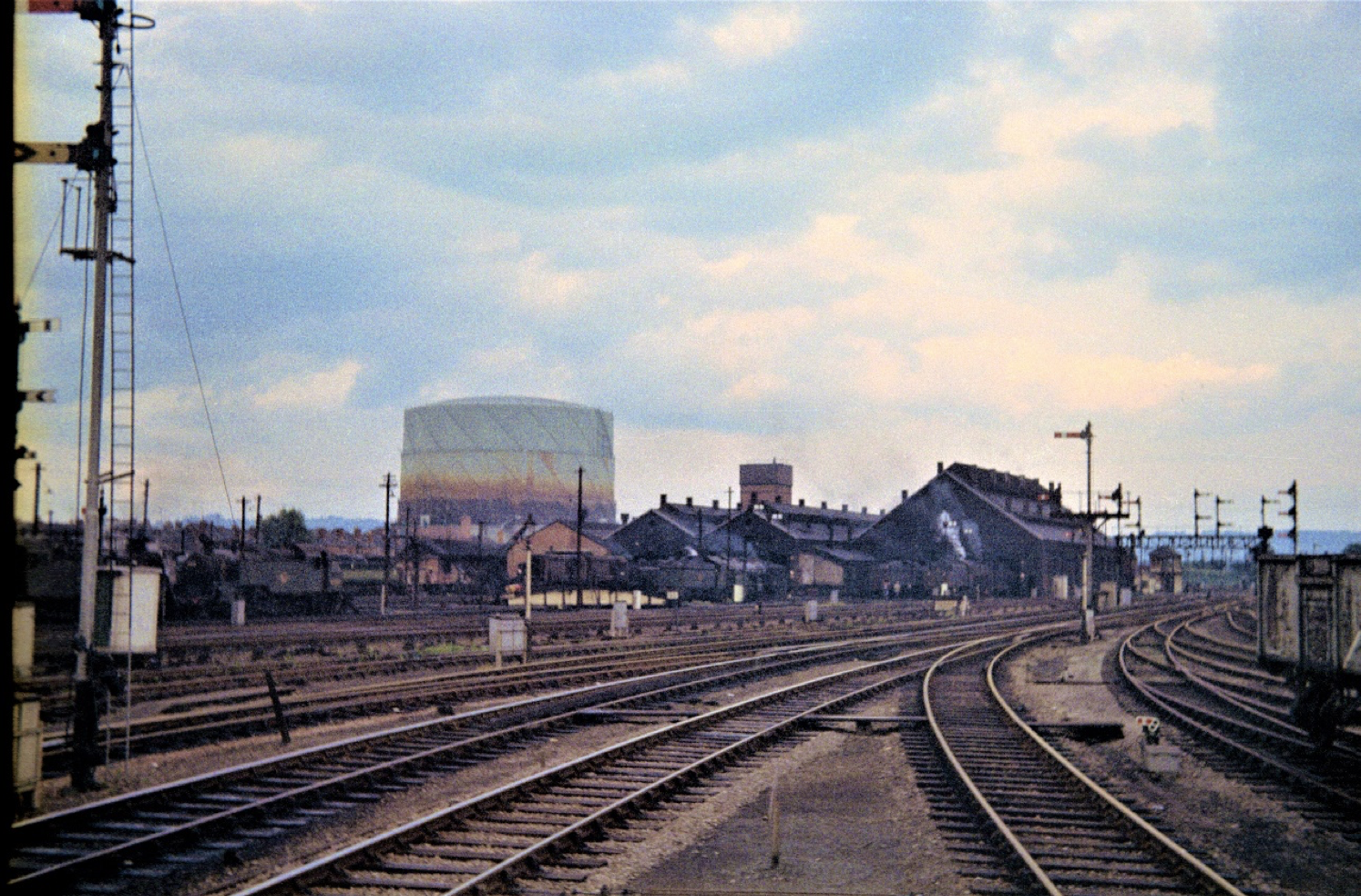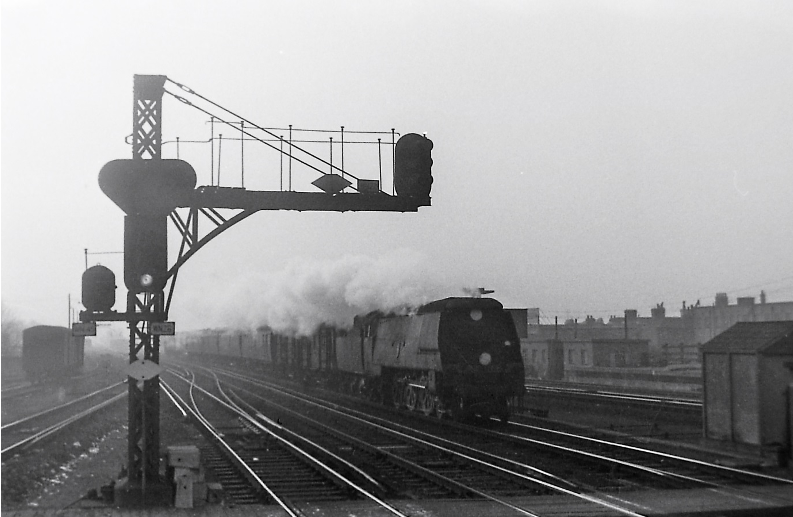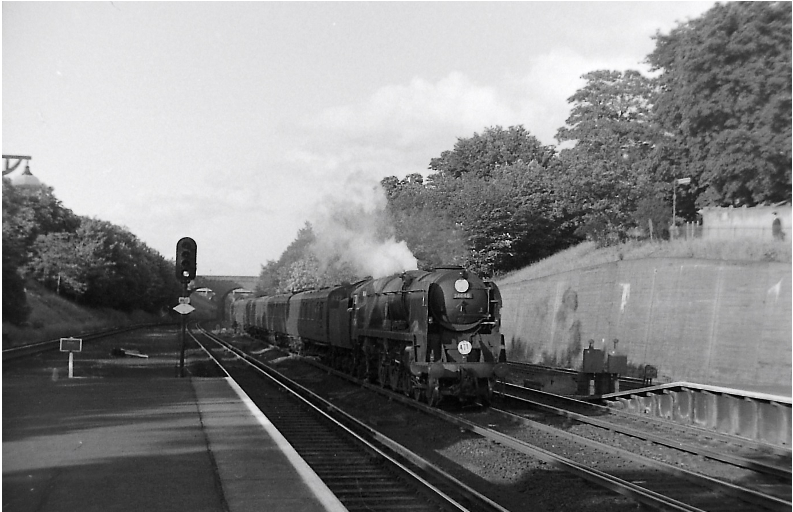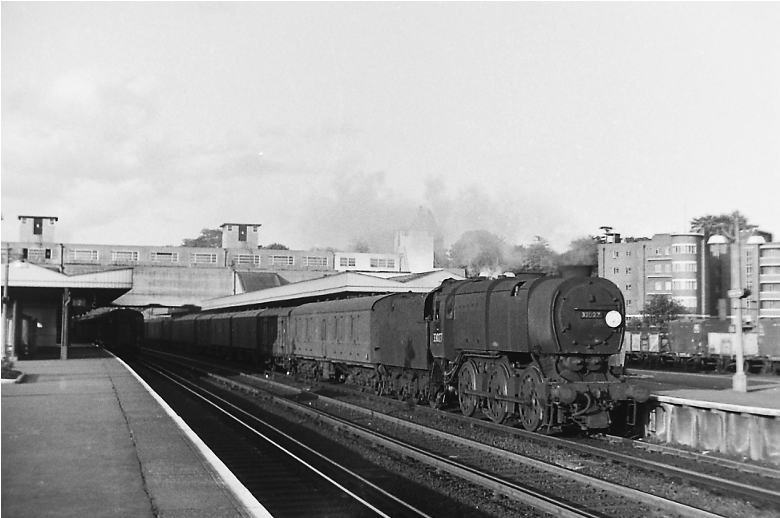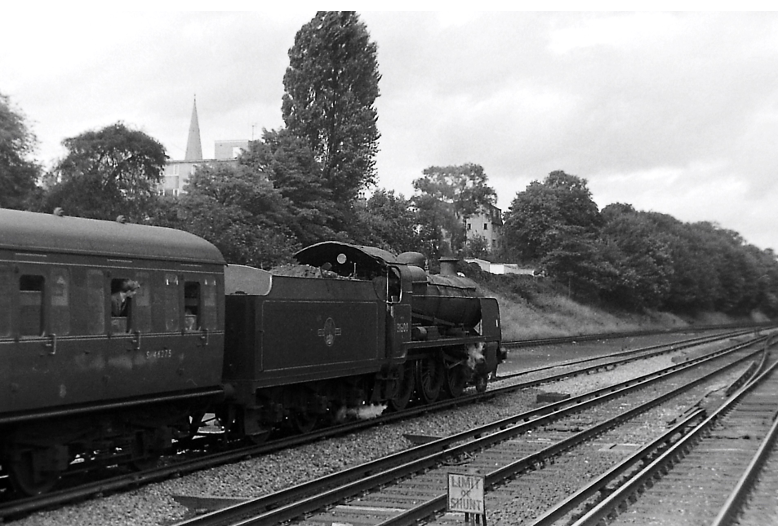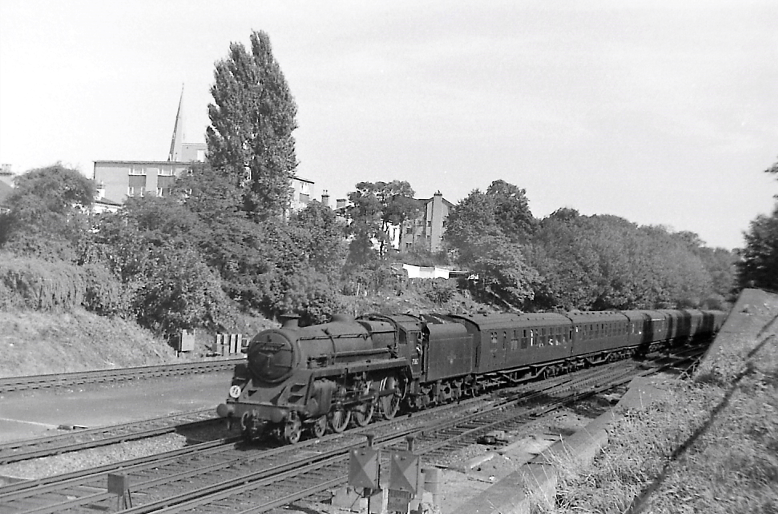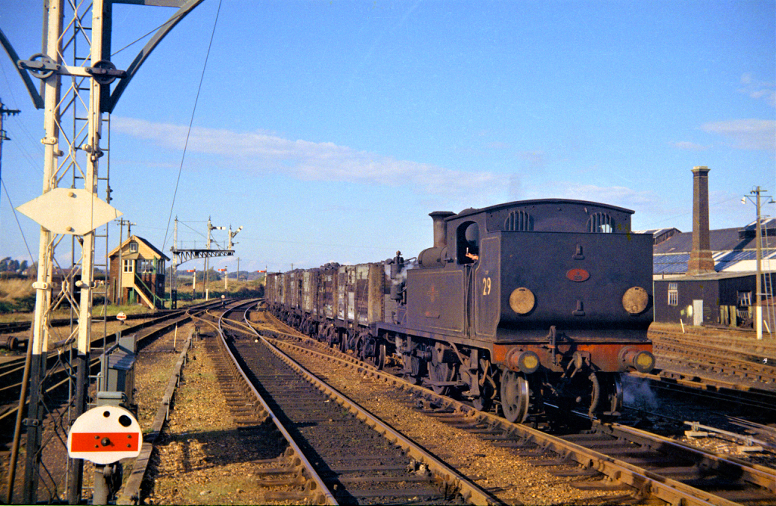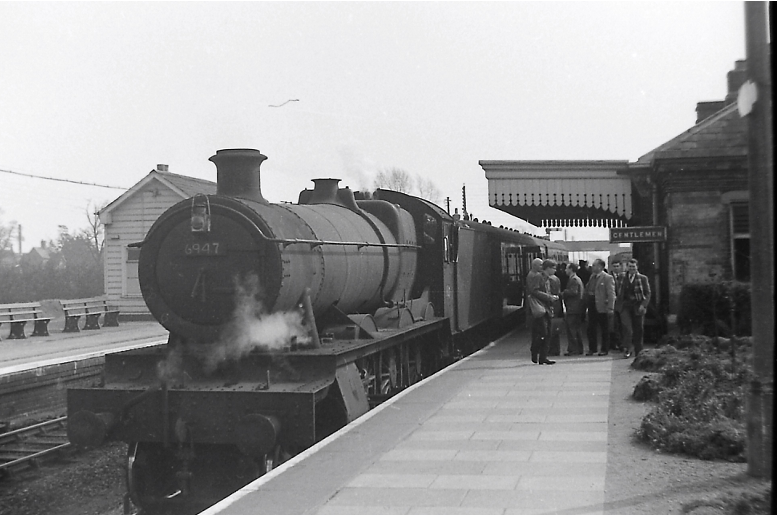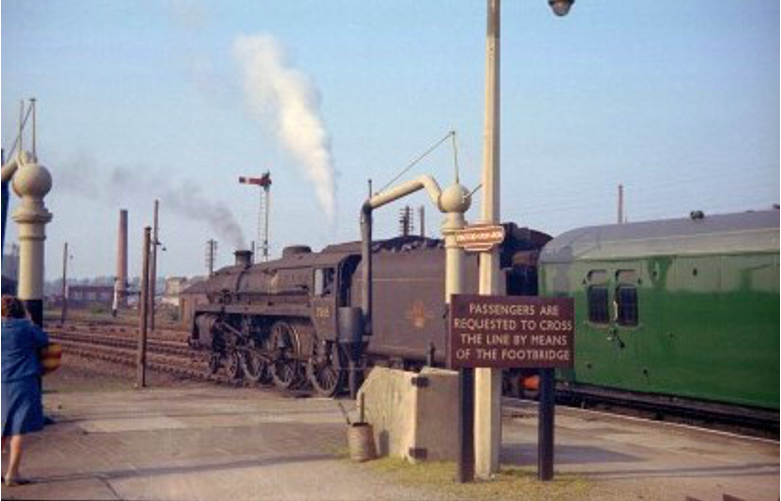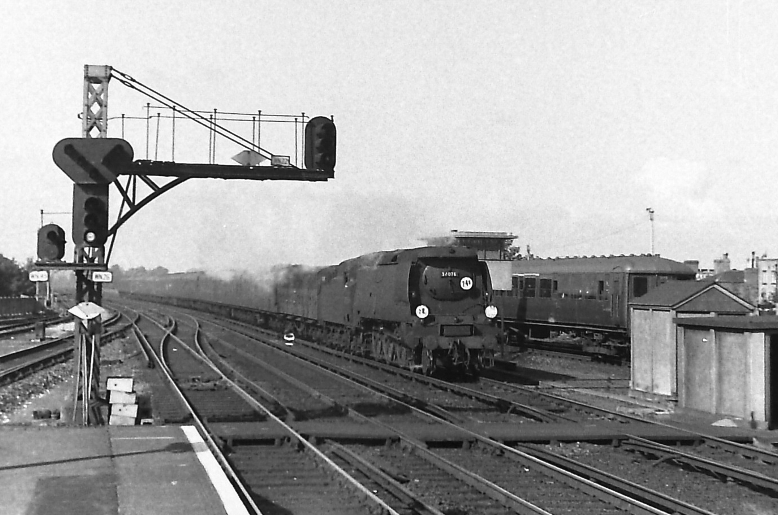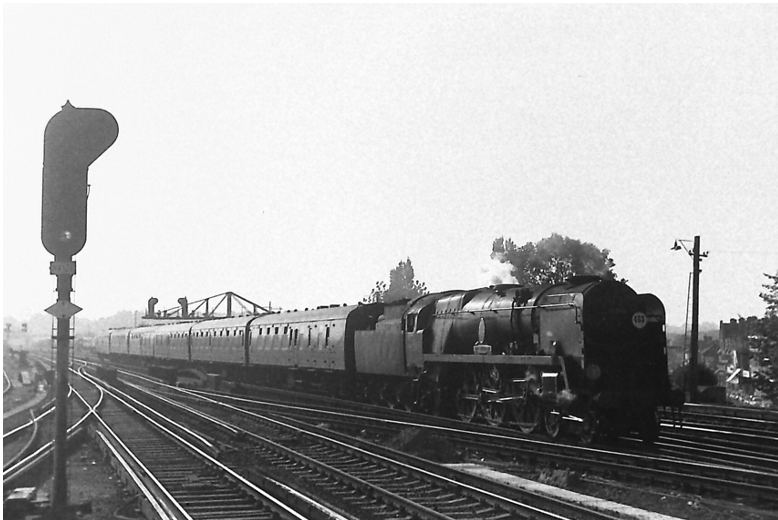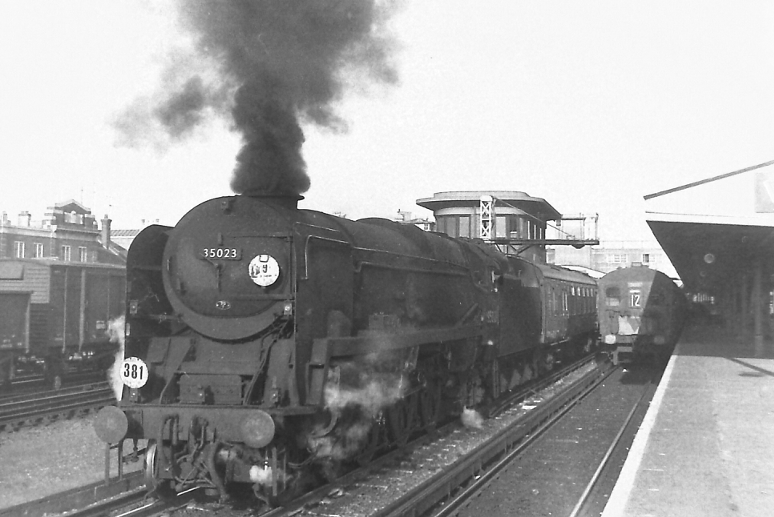1964-65: More Southern Steam
The three of us continued to meet up for more shed bashing, and so on 7 March we visited 1A and 14A. I was also still going on local trips by train: one to Watford again on 4 April to search out big LM steam was disappointing – the biggest locos I recorded were two ‘Jubilees’, as by now main-line express duties were firmly in the hands of the D200s.
On 27 June, I undertook another summer Saturday survey of traffic at Surbiton from 10am to 2pm, and again from 4.45pm to 7.30pm. This would be the last summer of Pacific steam on the Exeter line. The pattern of traffic was similar as previous years, with ‘S15’ No. 30830 working the Walton-on-Thames ECS duty at 11.45am. Several Southampton boat trains had to be fitted into the schedule as well that day, including one hauled by No. D6525 at 5.10pm connecting with a North German Lloyd Line sailing.
Bulleid Pacific No. 34019 Bideford approaches Surbiton from the west at the head of the 1pm Salisbury to Waterloo on 8 February 1964.
‘WC’ Pacific No. 34048 Crediton passes through Surbiton with the 6.54pm Waterloo to Salisbury on 5 June 1964.
‘Q1’ class 0-6-0 No. 33027 takes the down platform line through Surbiton with the 7.10pm parcels train to Woking on 5 June 1964.
‘U’ class 2-6-0 No. 31800 blasts away from Surbiton on the last leg of its journey to Waterloo with the 3.35pm from Salisbury on 11 July 1964. Note the first coach, S46275, is a Standard non-gangwayed vehicle. This service, departing Surbiton at 5.12pm was one of the few steam-hauled trains that could be used to travel locally from Surbiton to Waterloo.
Standard class ‘5’ 4-6-0 No. 73162 takes the down fast line through Surbiton with the Sunday 11.40 am to Bournemouth on 13 September 1964. The loco is not showing the correct route indicator, as it had transferred from the NE Region and was not yet equipped with the extra brackets placed centrally either side of the smokebox to display Southern route headcodes.
Following the take-over of the Salisbury – Exeter main line by the WR, plans were made to replace steam, and the last Atlantic Coast Express ran on 5 September 1964. The down train was worked by No. 35022 Holland-America Line to Exeter, and by No. 34015 Exmouth thence to Padstow. From 7 September, ‘Warships’ took over operation of the route, which was then only served by a semi-fast service that did not go beyond Exeter (‘Warships’ continued to work these services until replaced by Class 33s in October 1971). The only other express on this route was the daily Brighton – Plymouth train which continued to use the LSW route through Okehampton until its closure in on 6 May 1968.
On 12 June I paid a return visit to Guildford to witness the emotional last day of Horsham branch trains, still steam-hauled by Ivatt ‘2’ tanks. Then on 12 December I took my bicycle for a final visit to the steam-operated Guildford – Redhill line. In wet dank weather I managed to photograph on the North Downs line between Reigate and Gomshall, recording ‘N’ class 2-6-0s and Standard ‘4’ 4-6-0s. Steam was replaced on this route by ‘Hampshire’ diesel multiple units in January 1965, and Redhill MPD closed. On 7 October I also took another trip to photograph ‘O2s’ at Newport on the Isle of Wight. The line from Ryde to Newport and Cowes closed to passengers in February 1966, although coal continued to be imported through Medina Wharf, Cowes until May.
‘O2’ class 0-4-4T No. W29 Alverstone pulls into Newport Isle of Wight with a coal train from Medina Wharf, Cowes on 7 October 1964.
‘Talking of Trains’ railtour
I had been attending for a couple of years a series of Surrey County Council evening classes entitled ‘Talking of Trains’ at Surbiton WEA, held at the Institute on Surbiton Hill Road. They were organised by J Spencer-Gilks, who produced a range of books cataloguing the byways of the railway system prior Beeching, and the trips he organised reflected this. Our trip from Surbiton on 3 April 1965, although predominantly by steam, used the emu service to Alton, where we changed into a Hampshire DMU to Winchester. Here we boarded the ‘Pines Express’ as far as Oxford (it had been diverted from the S&D in 1962). Oxford had long been a place where locomotives form all four pre-grouping companies could be seen, and Bulleid Pacifics became a common sight there in the last days of steam on through services from the Southern region. On this occasion we were hauled by No. 35023 Holland-Afrika Line. We continued by a local train headed by ‘Hall’ 4-6-0 No. 6947 (minus nameplates) to Honeybourne, before getting a coach to Rugby.
‘Hall’ No. 6947 (once named Helmingham Hall but now minus nameplates) rests at Moreton-in-Marsh at the head of the two-coach 1.25pm from Oxford during the ‘Talking of Trains’ tour on 3 April 1965, organised by J Spencer-Gilks.
We travelled back on the GC to Marylebone on the 5.15pm ex-Nottingham, hauled by ‘Black 5’ No. 45298. By then, the GC was a shadow of its former self, the Sheffield and Manchester expresses having been withdrawn in 1960, with only a semi-fast service between Nottingham and Marylebone remaining. Annesley’s ‘9Fs’ were still working freight between Annesley and Woodford until the removal of freight traffic from the GC line on 16 April, when both sheds were closed, except for servicing. Indeed, whilst waiting at Rugby Central, No. 92096 hurried northbound with a freight that included a collection of brakevans. This was probably part of a program to clear Woodford Halse goods yard of excess vehicles prior to the imminent removal of all freight.
The ‘V2s’ once common on the GC line still penetrated to the southern end of the line, even in 1965, but had been largely replaced by LM locos, including ‘Royal Scots’, which had been cascaded from other areas through dieselisation. A residual local service ran between Rugby and Nottingham until 3 September 1966, motive power being provided from Banbury. Sheds at Canklow, Staveley GC and Retford all closed at the same time, their ‘WDs’, ‘O1s’ and ‘B1s’ being transferred to Colwick, Barrow Hill, Doncaster and 36C.
On 12 May I went that way again on a day excursion visiting Stratford-upon-Avon and Coventry, hauled throughout from Guildford by No. 73115 King Pellinore.
Standard ‘5’ 4-6-0 No. 73115 King Pellinore prepares to leave Stratford-upon-Avon with a return excursion to Portsmouth Harbour on 12 May 1965.
On 7 August, I took more notes of summer Saturday steam from Waterloo, although they were not complete. At Surbiton I photographed un-rebuilt Bulleid Pacific No. 34076 141 Squadron at the head on the 6.22am semi-fast from Bournemouth West to Waterloo. Down trains on the South-west main line were being mainly worked by ‘Warships’ but were not travelling beyond Exeter: Exmouth Junction MPD had closed to steam in May. Most Bournemouth and Weymouth trains were still steam worked, mainly by Bulleid Pacifics and Standard ‘5s’, but a sign of the times was a Salisbury local service worked by a WR 3-car Cross-country DMU set.
Bulleid Pacific No. 34076 141 Squadron approaching Surbiton from the west on the 6.22am Bournemouth to Waterloo on 7 August 1965 overtakes a stopping train composed of 2-BIL/HAL units from Portsmouth and Alton.
On 29 August I took a Sunday excursion to Norwich – an area I had not visited – but as East Anglia was by now completely dieselised, and I was not at that time interested in diesels I have no records of locos seen. However, I did have an enjoyable round trip, out via Ipswich and back via Thetford and Cambridge, and it was on the return, near Audley End, that I first encountered arable farmers burning stubble.
The day after, I was in Southampton again with my camera! Then, on 9 October, I was at Woking on another photographic expedition, and was rewarded with a shot of No. 35023, now filthy, at the head of the 3.35pm Waterloo – Bournemouth train.
On the last day of 1965 I travelled from home for a final trip on the S&D from Bath to Bournemouth, as steam was about to finish and the line to close. Our train was hauled by Standard 2-6-4T No. 80039 as far as Templecombe. Here, the Salisbury – Exeter train consisted of a 3-car cross-country DMU of the sort used in Devon and Cornwall. This was supposed to be the last day of steam operation on WR, but the S&D got a short stay of execution, and steam lasted a few more months on the S&D, finally ending on 5 March 1966, with the withdrawal of the service along with the local service from Bristol to Bath Green Park via Mangotsfield.
Two photographs taken at Woking on 9 October 1965:
Above: ‘BB’ 4-6-2 No. 34089 602 Squadron at the head of the 1pm Bournemouth West to Waterloo.
Below: A filthy ‘Merchant Navy’ class 4-6-2 No. 35023 Holland-Afrika Line in charge of the 3.35pm from Waterloo to Bournemouth stokes up for the next stage of its journey.
